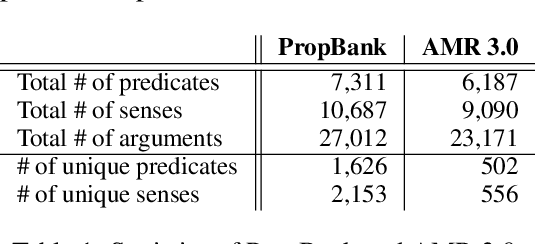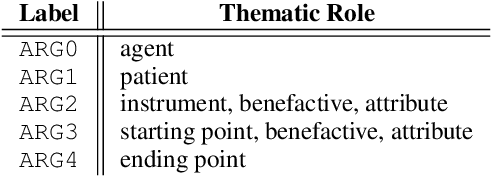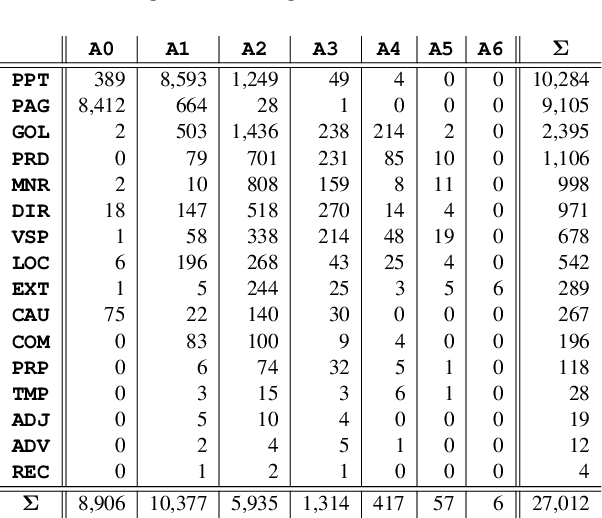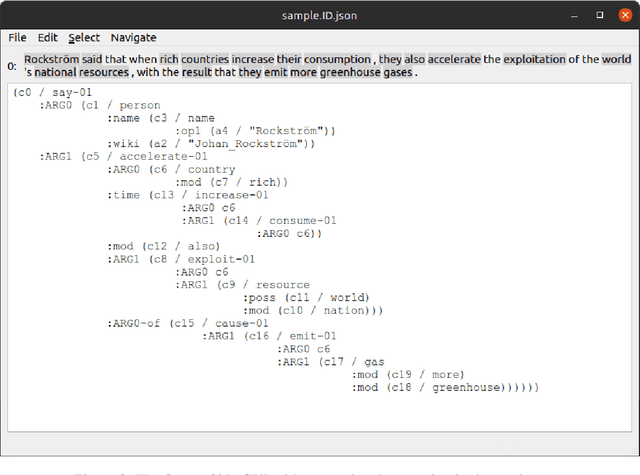Gregor Williamson
Widely Interpretable Semantic Representation: Frameless Meaning Representation for Broader Applicability
Sep 12, 2023



Abstract:This paper presents a novel semantic representation, WISeR, that overcomes challenges for Abstract Meaning Representation (AMR). Despite its strengths, AMR is not easily applied to languages or domains without predefined semantic frames, and its use of numbered arguments results in semantic role labels, which are not directly interpretable and are semantically overloaded for parsers. We examine the numbered arguments of predicates in AMR and convert them to thematic roles that do not require reference to semantic frames. We create a new corpus of 1K English dialogue sentences annotated in both WISeR and AMR. WISeR shows stronger inter-annotator agreement for beginner and experienced annotators, with beginners becoming proficient in WISeR annotation more quickly. Finally, we train a state-of-the-art parser on the AMR 3.0 corpus and a WISeR corpus converted from AMR 3.0. The parser is evaluated on these corpora and our dialogue corpus. The WISeR model exhibits higher accuracy than its AMR counterpart across the board, demonstrating that WISeR is easier for parsers to learn.
Intensionalizing Abstract Meaning Representations: Non-Veridicality and Scope
Sep 20, 2021Abstract:Abstract Meaning Representation (AMR) is a graphical meaning representation language designed to represent propositional information about argument structure. However, at present it is unable to satisfyingly represent non-veridical intensional contexts, often licensing inappropriate inferences. In this paper, we show how to resolve the problem of non-veridicality without appealing to layered graphs through a mapping from AMRs into Simply-Typed Lambda Calculus (STLC). At least for some cases, this requires the introduction of a new role :content which functions as an intensional operator. The translation proposed is inspired by the formal linguistics literature on the event semantics of attitude reports. Next, we address the interaction of quantifier scope and intensional operators in so-called de re/de dicto ambiguities. We adopt a scope node from the literature and provide an explicit multidimensional semantics utilizing Cooper storage which allows us to derive the de re and de dicto scope readings as well as intermediate scope readings which prove difficult for accounts without a scope node.
StreamSide: A Fully-Customizable Open-Source Toolkit for Efficient Annotation of Meaning Representations
Sep 20, 2021



Abstract:This demonstration paper presents StreamSide, an open-source toolkit for annotating multiple kinds of meaning representations. StreamSide supports frame-based annotation schemes e.g., Abstract Meaning Representation (AMR) and frameless annotation schemes e.g., Widely Interpretable Semantic Representation (WISeR). Moreover, it supports both sentence-level and document-level annotation by allowing annotators to create multi-rooted graphs for input text. It can open and automatically convert between several types of input formats including plain text, Penman notation, and its own JSON format enabling richer annotation. It features reference frames for AMR predicate argument structures, and also concept-to-text alignment. StreamSide is released under the Apache 2.0 license, and is completely open-source so that it can be customized to annotate enriched meaning representations in different languages (e.g., Uniform Meaning Representations). All StreamSide resources are publicly distributed through our open source project at: https://github.com/emorynlp/StreamSide.
 Add to Chrome
Add to Chrome Add to Firefox
Add to Firefox Add to Edge
Add to Edge